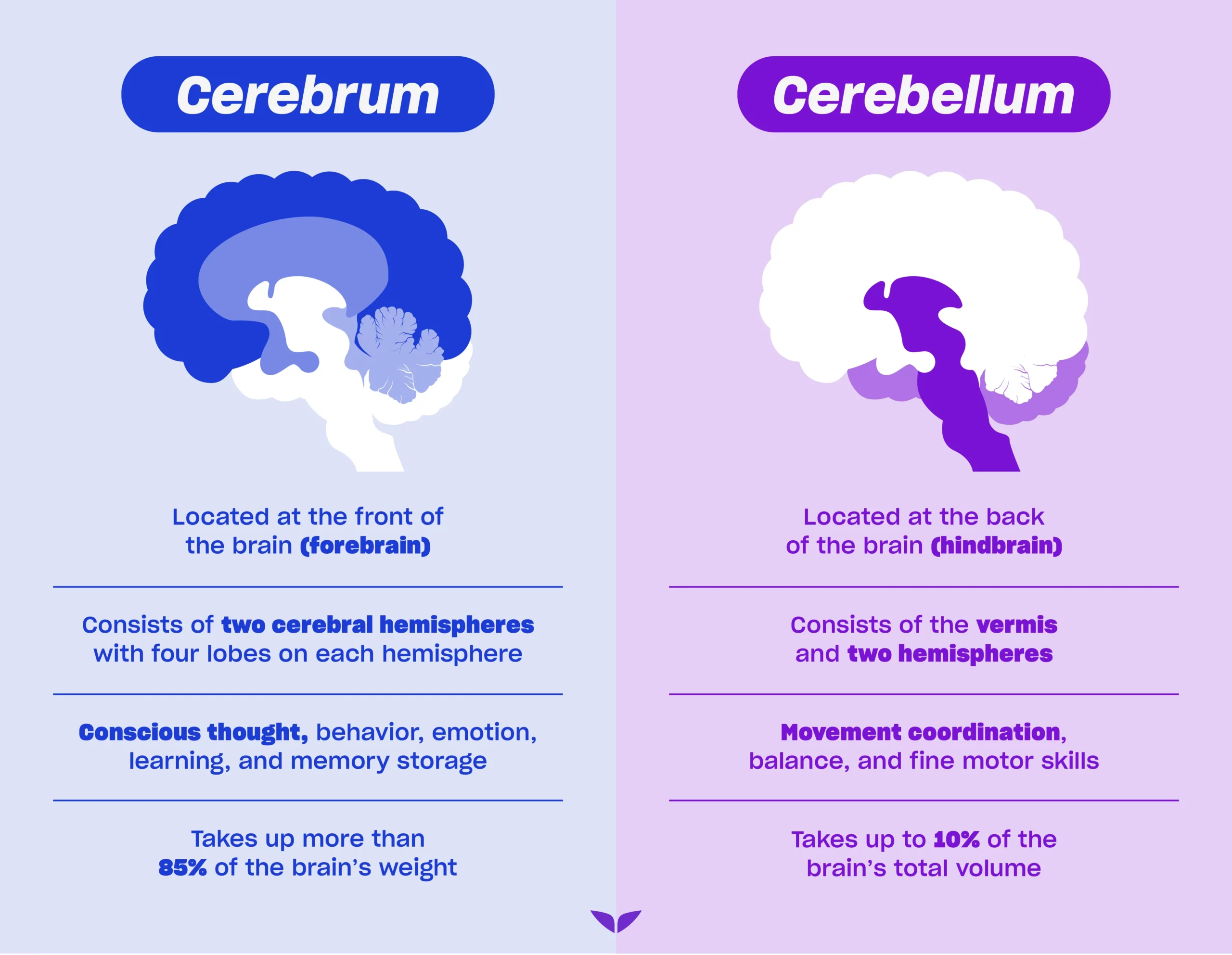With more than 85 billion functional neurons, the brain is no doubt one of the most enigmatic organs in the human body. It can do anything, from composing music to solving the trickiest mathematical equations.
Is it powerful? Certainly.
Are you utilizing its full potential? Probably not.
If you’re going to demystify your brain, it’s best to lay out the facts first. And a good place to start is by understanding the notorious cerebrum vs. cerebellum comparison better.
Now, you may remember these terms from your biology class or your recent Grey’s Anatomy marathon. But what are the main differences between these two areas of the brain?
Jim Kwik, international brain coach and trainer of Mindvalley’s Superbrain Quest, couldn’t have said it better:
We need to understand how our minds work so we can work our minds better.
— Jim Kwik, trainer of Mindvalley’s Superbrain Quest
Knowing how your brain functions might be the first step toward unlocking its true power.
Cerebrum vs. Cerebellum: Key Differences
While the cerebrum and cerebellum are utterly fascinating and slightly confusing at first, understanding them is not that difficult.
Although they both play equally important roles, there are major differences between the two brain regions.
Let’s compare them in more detail:

Until recently, only the cerebrum was associated with memory.
However, according to new research from the University of Basel, “the cerebellum, which was known primarily for regulating movement, also plays a key role in storing both positive and negative memories of emotional events.”
Cerebellum vs. Cerebrum vs. Brain Stem
Picture this: The two brain areas are about to have an epic cerebrum vs. cerebellum face-off in the battle for brain brilliance.
Just as they’re entering the ring, a third contender appears—the brain stem.
Considered the oldest and most important part of the brain, think of it as the moveable bridge that all the signals from the brain have to pass through before spreading to the rest of the body.
Similar to most areas of the brain, this section consists of individual components: the medulla oblongata, the pons, and the midbrain. And here are a few things about your brain stem function you should know:
- The medulla oblongata. This structure regulates body functions that feel like they’re on “autopilot,” including your breathing, blood pressure, heart rate, and digestion. It is also responsible for reflexes of the face and throat, like coughing, swallowing, and blinking.
- The pons. This area, which is located in the middle portion of the brain stem, connects each side of the cerebellum to the opposite hemisphere. It also plays a major role in facial movement coordination, balance, and hearing.
- The midbrain. The upper area of the midbrain aids in voluntary movement, visual and auditory processing, and consciousness, while the lower area is responsible for controlling your reflexes to pain and temperature. So the next time you take a sip of coffee that’s too hot, you can blame your midbrain for telling you to spit it out all over your new rug.
Cerebrum
If the brain is a thriving enterprise, the cerebrum is the mastermind CEO. It oversees strategic planning, decisions, and complex cognitive tasks.
It’s the largest part of your brain and is responsible for controlling mental functions like learning and speech. It actually takes up more than 85% of its weight.
It has two hemispheres—the left and the right. The right hemisphere controls the left side of your body, and vice versa.
The two hemispheres can be further broken down into four lobes: the frontal, parietal, occipital, and temporal lobes. And each one controls specific areas of the thinking process.
Cerebrum function
Even though the cerebrum is considered the thinking part of your brain, its abilities extend far beyond simply helping you play chess.
To get a better glimpse into its intricate nature, here are the main functions of the cerebrum:
- Your five senses. The cerebrum manages and processes information from your sight, sound, smell, taste, and touch. It creates your perception of the world, allowing you to appreciate the beauty of a sunset or savor the aroma of a fresh bagel.
- Short-term memory. It helps you remember things, like when you remind yourself to pick up groceries on the way back from work.
- Behavior and personality. It regulates your self-control and emotions. And it helps stop you from doing or saying things you’ll probably regret.
- Learning, logic, and reasoning. Different areas of your cerebrum work together to facilitate learning and higher cognitive functions. For example, it helps you solve sudoku puzzles or plot your next attack in a strategy game.
- Language skills. The cerebrum’s frontal and temporal lobes are primarily involved in speech formation and understanding. They help you comprehend, process, and produce language.
Cerebrum location
The cerebrum is located in the upper part of the cranial cavity. At the top and front of your brain.
Cerebellum
The cerebrum is your brain’s CEO. And every CEO needs a top-notch senior management team to keep the business moving. That’s exactly what the cerebellum does.
It works behind-the-scenes to coordinate your movements, balance, and fine motor skills.
The name “cerebellum” derives from Latin and means “little brain.” While it only takes up around 10% of your brain’s total volume, it’s mighty. In fact, it contains 69 billion neurons, which is more than 50% of the neurons in your brain.
Cerebellum function
Your cerebellum may be called your “little brain,” but it does some pretty big things.
To better highlight the differences in cerebrum vs. cerebellum function, here’s a breakdown of the most important role of the cerebellum:
- Movement coordination. The cerebellum helps fine-tune the force, timing, and accuracy of your movements.
- Balance and posture. It adjusts your body’s position in response to changing environments. This allows you to navigate uneven terrain and maintain equilibrium during complex movements.
- Fine motor movements. The cerebellum also facilitates motor learning and skill acquisition, like making sure you don’t poke yourself while knitting.
Cerebellum location
The cerebellum is located at the back of your head. Just above and behind your brain stem, the area where your spinal cord connects to your brain.
How to Take Care of Your Brain: 10 Tips From Brain Performance Coach Jim Kwik
Have you ever relied on a mental grocery list only to realize you forgot to buy a bunch of items after you left the store?
Or what about a campaign idea that popped into your mind in the shower, and you told yourself you’d write it down as soon as you got out, only to forget about it minutes later?
While there’s no magic pill to boost your IQ, there are ways to increase your brain power and improve your memory.
And in his Superbrain Quest on Mindvalley, Jim shares his top 10 practical tips that can absolutely help:
1. Maintain a good brain diet
When it comes to bolstering your brain to do its best work, the saying “You are what you eat” holds true. To keep your brain happy and thriving, include foods like blueberries, avocados, wild salmon, walnuts, and dark chocolate in your diet.
Tip from Jim Kwik: “Add as many brain foods as possible to your diet.“
2. Kill ANTs
You might be thinking, “Killing ants is scientifically proven to give you a better brain?” In this case, ANTs stand for: automatic negative thoughts.
The thing is, your mind is always eavesdropping on your self-talk. So every time you have a negative thought, just add the word “yet” at the end.
For example, instead of saying “I’m not very good at learning,” change it to “I’m not very good at learning yet.”
See how a simple, three-letter word opens up so many possibilities?
Tip from Jim Kwik: “Your brain is like a supercomputer, and your self-talk is the program it will run.“
3. Exercise
According to new research, anything that’s good for your heart is good for your brain. People who exercise perform better on mental acuity tests, have sharper focus, and have a better memory.
And you don’t need to become a fitness guru. Simply find the type of movement you enjoy doing the most and get that heart rate up.
Tip from Jim Kwik: “One of the best ways to change your state is by moving your body, right? Because as your body moves, your brain grooves… You create more neurogenesis [and] neuroplasticity.”
4. Get your brain nutrients
A study published in Public Health Nutrition shows that foods rich in vitamins, minerals, antioxidants, polyphenols, and omega-3 fatty acids can help increase brain power by improving memory and concentration.
To determine if you aren’t getting the nutrients you need from your diet, have a simple blood test done. If there are areas where you’re lacking, help your brain work at maximum levels by taking the right supplements.
Tip from Jim Kwik: “In today’s modern-day lifestyle, we’re on the go, everything is fast food. Maybe we’re not getting the nutrients we need. There are certain brain nutrients that are very important for your brain to be optimized and work at top speed and top function. So things like your B vitamins, things like omega 3s, very important.“
5. Surround yourself with positive people
Have you heard of “energy vampires”? They zap your energy and leave you feeling drained after every conversation.
In order to level up your brain, you should spend time with people who are encouraging and challenging you. So, embrace your inner Buffy and slay those energy vampires.
Make sure everyone you choose to surround yourself with is good for your mind and your soul.
Tip from Jim Kwik: “Who you spend time with is who you become. Finding a positive peer group of people who challenge you and who are smarter than you will help you become a real-life superhero.“
6. Have a clean environment
Pizza boxes and piles of clothing stacked around the house may seem harmless. However, research shows disorganization and clutter can have negative effects on your brain.
The brain likes order, and non-stop visual reminders of disorder drain your mind’s resources, reducing your ability to focus. So make sure to declutter your space.
Tip from Jim Kwik: “As you clear on the outside, you clear on the inside. You have better focus, you have clearer thinking.“
7. Sleep
A good night’s sleep is essential if you want to improve your memory. This is because, during sleep, you convert short-term to long-term memory.
Just like exercise tears muscles and rest regenerates them, sleeping can help your brain focus, think more clearly, and make better decisions.
Also, research suggests that when you sleep, you’re clearing out your brain of plaque that can lead to conditions like dementia and Alzheimer’s.
Tip from Jim Kwik: “One of the best ways to enhance your quality of sleep is a mindfulness practice. So for me, I meditate in the morning, and at night for 20 minutes. First thing in the morning, and then last thing at night before going to bed.
And research suggests those who meditate also report deeper levels of sleep, and they don’t wake up quite as much.“
8. Protect your brain
Your brain is resilient, but it’s also fragile. So if you’re an adrenaline junkie or a motorcycle lover, protect your most valuable asset by always wearing a helmet.
According to the Centers for Disease Control and Prevention, there are an estimated 1.7 to 3.8 million traumatic brain injuries each year in the United States. Out of these, 10% are caused by sports and recreational activities.
Tip from Jim Kwik: “Take it from me, from somebody who’s had so many accidents: head traumas, falling many times, concussions—it has a great impact on your learning abilities. I had these learning challenges because I had this brain injury and this head trauma. So, protect your brain.“
9. Keep learning
One of the benefits of life-long learning is that it adds years to your life. The famous Nun Study found that nuns remained agile as they grew older. This is not only due to their faith but also because they were lifelong learners.
So, dedicate 10 minutes to learning something new every single day.
Tip from Jim Kwik: “Keep learning; that’s what you really want to commit to. That’s why it’s so important to not miss a day because consistency is power.“
10. Manage your stress
What the Joker is to Batman, stress is to your brain.
Being in a stressful state activates your fight-or-flight mode and releases cortisol and adrenaline into your body. This is great if you need to escape from a bear, but not if you’re about to enter an interview or give a presentation.
When you’re stressed, your mind goes blank; it literally shuts down. So, managing your stress levels is also crucial.
Tip from Jim Kwik: “Massage, yoga, mindfulness training, meditation—all those things could help lower your stress, your cortisol, and your adrenaline levels.“
Unlock the Power of Your Superbrain
There are no limitations when it comes to your brain. You are capable of becoming happier, healthier, and more successful through the power of your mind.
Using the right tools can make all the difference, whether you’re training for a triathlon or trying to ace your next exam. And if you need some help unlocking your superbrain, the answer lies in Mindvalley’s free Superbrain Masterclass, guided by Jim Kwik.
This exclusive 82-minute masterclass is jam-packed with wisdom, hacks, and techniques to help unleash your brain’s limitless potential. You’ll learn how to:
- Clear up “mental fog,”
- Activate untapped areas of your brain,
- Optimize your brain’s ability with the perfect morning routine, and
- So much more.
As Jim says, “If knowledge is power, learning is your superpower.” And your learning starts at Mindvalley.
Welcome in.









